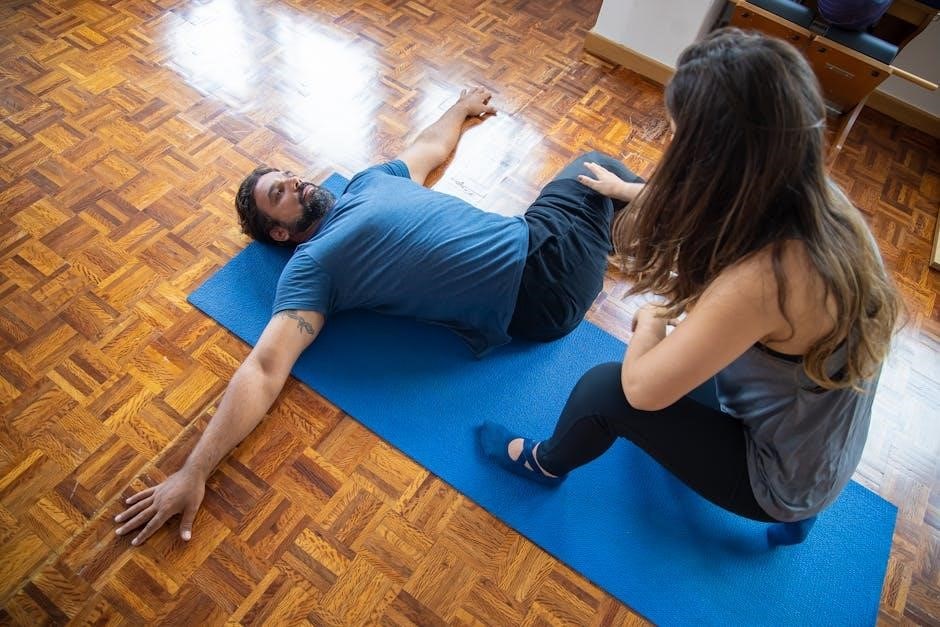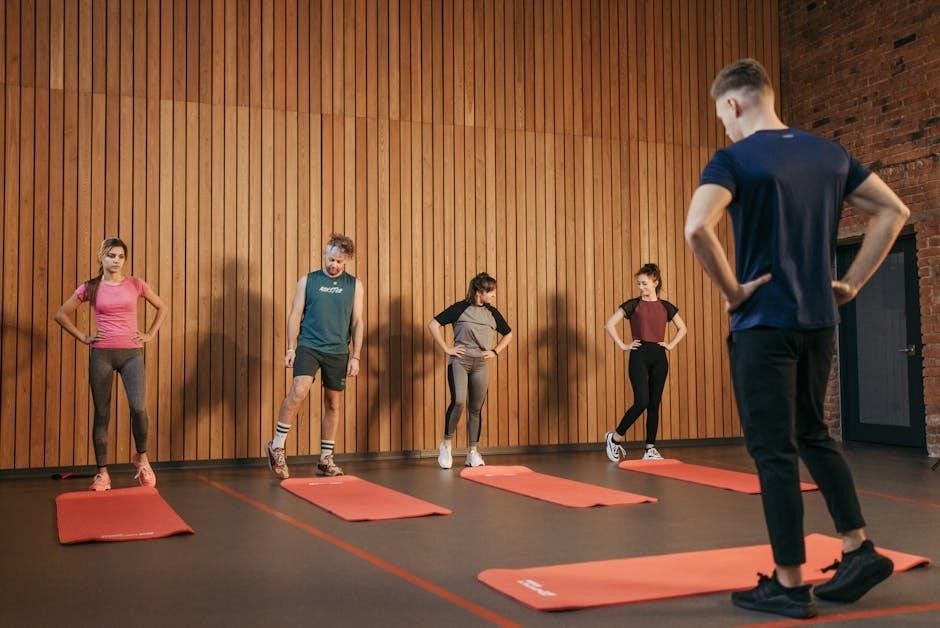800 meter training program pdf

Matering the 800m requires a well-structured training program that builds aerobic endurance‚ speed‚ and strength. This guide provides a comprehensive approach to optimize performance and achieve race goals effectively.
Overview of the 800 Meter Event
The 800-meter race is a middle-distance event that demands a perfect balance of speed and endurance. It requires athletes to maintain a fast pace over two laps of the track‚ making it both physically and mentally challenging. A well-structured training program is essential to optimize performance‚ focusing on building aerobic capacity‚ anaerobic endurance‚ and race-specific strategies. This guide provides a detailed approach to help athletes of all levels master the 800m‚ offering practical workouts‚ recovery tips‚ and race tactics to achieve personal bests and competitive success.
Importance of a Structured Training Program
A structured training program is crucial for achieving success in the 800-meter event. It ensures athletes progressively build endurance‚ speed‚ and strength while minimizing the risk of overtraining and injury. A well-designed program allows for proper periodization‚ enabling peak performance during key competitions. By incorporating specific workouts like interval training and tempo runs‚ athletes can enhance both aerobic and anaerobic capacities. Consistency and adherence to the program are key to seeing continuous improvement and reaching personal best times. A structured approach also helps athletes stay motivated and focused‚ ensuring they are prepared for race day.

Understanding the Physiology of 800 Meter Running
800m running relies on both aerobic and anaerobic energy systems‚ requiring a balance between endurance and speed. Proper training enhances lactate threshold and muscular efficiency for optimal performance.
Aerobic and Anaerobic Energy Systems
The 800m event heavily relies on both aerobic and anaerobic energy systems. The aerobic system provides sustained energy through oxygen‚ while the anaerobic system delivers short bursts of power without oxygen. During the race‚ runners primarily use the anaerobic system for the initial sprint and the aerobic system for maintaining pace. A well-structured training program should focus on enhancing both systems to improve endurance and speed. This balance is crucial for optimal performance and achieving race goals effectively.
Role of Lactate Threshold in 800 Meter Performance
Lactate threshold plays a critical role in 800m performance‚ as it determines the point at which lactic acid accumulates in the muscles‚ leading to fatigue. Training to increase this threshold enhances the body’s ability to tolerate high-intensity efforts. Workouts such as interval training and tempo runs are essential for improving lactate threshold‚ allowing runners to sustain faster paces longer. A higher lactate threshold directly translates to better performance‚ making it a key focus in any 800m training program. This physiological adaptation is vital for achieving competitive race times and maintaining consistency throughout the event.
Factors Influencing Endurance and Speed
Endurance and speed in 800m running are shaped by a combination of genetic‚ physiological‚ and training-related factors. Aerobic capacity‚ muscular efficiency‚ and neuromuscular coordination play significant roles. Consistent training volume‚ intensity‚ and proper recovery are essential for building endurance‚ while speed is enhanced through high-intensity interval workouts and strength training. Nutrition‚ hydration‚ and overall health also influence performance‚ as they support energy production and muscle function. Balancing these elements ensures optimal development of both endurance and speed‚ enabling athletes to achieve peak performance in the 800m event.

Key Components of an 800 Meter Training Program
A successful 800m program includes aerobic base building‚ speed and endurance workouts‚ strength training‚ and periodization. These elements ensure a balanced approach to enhancing performance and reducing injury risk.
Building an Aerobic Base
Building an aerobic base is foundational for 800m training‚ focusing on long slow distance (LSD) runs and interval workouts. These sessions enhance cardiovascular efficiency‚ increasing oxygen delivery to muscles. Tempo runs at threshold pace also improve lactate threshold‚ delaying fatigue. Incorporating strength and mobility exercises supports endurance. A structured weekly plan ensures progressive overload‚ with rest days for recovery; This phase establishes the endurance needed for speed and race-specific training‚ making it essential for runners of all levels. Consistency and patience are key‚ as a strong aerobic base takes time to develop.
Incorporating Speed and Endurance Workouts
Incorporating speed and endurance workouts is crucial for 800m training‚ as it enhances both aerobic and anaerobic capacities. Interval training‚ such as 400m or 200m repeats‚ improves race-specific speed and endurance. Tempo runs at a faster pace than easy runs help build lactate threshold‚ reducing fatigue during races. These workouts should be progressive‚ increasing intensity and volume over time. Combining speed and endurance ensures athletes can maintain pace over the final 400m. Proper recovery between sessions is essential to avoid injury and optimize performance. This balanced approach prepares runners for the demands of the 800m event.
Strength and Mobility Training
Strength and mobility training are essential for 800m runners‚ enhancing power‚ stability‚ and injury resistance. Core exercises like planks and Russian twists improve stability‚ while plyometrics‚ such as jump squats‚ boost explosive power. Mobility drills‚ including dynamic stretches and leg swings‚ maintain flexibility and range of motion. Incorporating strength training 2-3 times weekly with resistance bands or light weights helps build muscular endurance. These exercises complement running by addressing imbalances and reducing injury risk. A well-rounded strength program ensures runners can maintain form and power throughout the race‚ particularly in the final sprint to the finish line.
Periodization of Training
Periodization is a structured approach to training that divides the season into specific phases‚ each with distinct goals. For 800m runners‚ this typically includes a base phase focusing on endurance‚ a build-up phase introducing speed and intensity‚ and a competition phase with race-specific workouts. Deload weeks are incorporated to allow recovery and prevent overtraining. This cyclical structure ensures progressive overload‚ peaking fitness for key events‚ and sustained performance throughout the season. Proper periodization balances volume‚ intensity‚ and recovery to optimize results and minimize injury risks‚ making it a cornerstone of elite-level training programs.

Sample 800 Meter Training Program PDF
A comprehensive guide detailing structured workouts‚ weekly schedules‚ and progressive overload strategies. Designed to enhance endurance‚ speed‚ and race readiness‚ it includes sample workouts‚ variations in intensity and duration‚ and essential rest and recovery days to ensure peak performance. Perfect for athletes and coaches seeking a clear‚ goal-oriented training plan tailored to the demands of the 800-meter event.
Weekly Training Structure
A well-organized weekly plan is essential for 800m success. Typically‚ it includes 5-7 workouts: endurance runs‚ interval sessions‚ tempo runs‚ speed workouts‚ and long slow distance (LSD) runs. One or two rest days are crucial for recovery. Each session targets specific energy systems‚ with progressive overload to build fitness. For example‚ Mondays might focus on aerobic endurance‚ Wednesdays on speed‚ and Saturdays on race-pace simulations. Sundays are often reserved for LSD runs to enhance stamina. The structure ensures balanced development of speed‚ endurance‚ and recovery‚ aligning with the athlete’s goals and competition schedule.
Workout Examples and Progressions
Effective 800m training incorporates varied workouts to build speed‚ endurance‚ and race-specific fitness. Common sessions include interval training (e.g.‚ 4-6 x 400m at race pace)‚ tempo runs (e.g.‚ 4-6 x 200m with short rest)‚ and long slow distance (LSD) runs for aerobic endurance. Progressions involve increasing intensity‚ volume‚ or reducing rest periods. For example‚ start with 400m repeats at 3:00 min pace and gradually lower the target time. Incorporate progressive overload to ensure continuous improvement. Over time‚ introduce race-pace simulations (e.g.‚ 2-3 x 600m) to refine race execution. This structured approach ensures athletes peak for competition while minimizing injury risk.
Incorporating Rest and Recovery
Rest and recovery are critical components of an 800m training program‚ allowing the body to adapt and rebuild. Schedule rest days or active recovery‚ such as light jogging or stretching‚ to prevent overtraining. Techniques like foam rolling‚ ice baths‚ and quality sleep aid in muscle repair and reduce inflammation. Incorporate recovery weeks or deload phases every 4-6 weeks to maintain long-term progress. Neglecting recovery can lead to injuries and performance plateaus‚ making it essential to balance intense training with proper rest strategies for optimal results.

Speed and Endurance Workouts
Speed and endurance workouts are essential for 800m training‚ combining interval training‚ tempo runs‚ and long slow distance runs to enhance race performance and stamina.
Interval Training for Speed Development
Interval training is a cornerstone of 800m speed development‚ involving repeated high-intensity runs with recovery periods. Typical workouts include 200m or 400m repeats at a fast pace‚ with rest intervals. This method enhances anaerobic capacity‚ critical for the 800m event. For example‚ 4-6 repetitions of 200m at 3-5 seconds faster than race pace improve speed endurance. Longer intervals‚ like 400m repeats‚ build lactate threshold and race-specific fitness. Coaches often adjust distances and recovery based on athlete goals and current fitness levels to optimize performance and prevent overtraining.
Tempo Runs for Endurance Building
Tempo runs are essential for building the cardiovascular endurance needed in 800m training. These sustained efforts at a moderate pace‚ typically 10-15 seconds slower than race pace‚ improve lactate threshold and mental stamina. A common session might involve a 20-minute continuous run or broken into segments like 5 x 1 mile at tempo pace with short recoveries. This approach helps athletes adapt to race-specific demands‚ enhancing their ability to maintain a strong pace throughout the event while building both physical and mental resilience for competition.
Long Slow Distance (LSD) Runs
Long Slow Distance runs are a cornerstone of endurance training‚ crucial for building a strong aerobic base. These low-intensity‚ extended runs promote cardiovascular adaptation‚ increase mitochondrial density‚ and enhance fat utilization as a fuel source. LSD runs typically range from 6 to 12 miles at a conversational pace‚ allowing athletes to recover between hard training sessions. They improve mental toughness and teach the body to sustain prolonged efforts‚ which is vital for maintaining consistent pacing in the 800m event. Incorporating LSD runs weekly ensures a solid foundation for more intense workouts and race-specific training.

Strength and Mobility Training
Strength and mobility training enhances power‚ flexibility‚ and injury resistance‚ combining exercises like plyometrics‚ core work‚ and dynamic stretches to improve running efficiency and overall athleticism.
Core Exercises for Stability
Core exercises are essential for stability‚ posture‚ and injury prevention in 800m training. Planks‚ side planks‚ and bird dogs strengthen the abdominals and lower back‚ improving running efficiency. Russian twists and leg raises target obliques for rotational power. Consistent core work enhances overall athleticism‚ reducing injury risk and boosting performance. Incorporate these exercises 2-3 times weekly for optimal results. A strong core provides the foundation for explosive starts and sustained speed‚ making it a critical component of any 800m training program.
Plyometrics for Explosive Power
Plyometric exercises are crucial for developing explosive power‚ essential for sprinting and maintaining speed in the 800m. Box jumps‚ burpees‚ and depth jumps improve power output by enhancing neuromuscular coordination. These exercises target fast-twitch muscle fibers‚ increasing acceleration and endurance. Incorporate plyometrics 1-2 times weekly‚ focusing on proper technique to avoid injury. Examples include jump squats‚ lateral bounds‚ and plyometric lunges. Consistency in plyometric training enhances race performance by boosting speed and stamina‚ making it a vital component of an 800m training program.
Flexibility and Stretching Routines
Flexibility and stretching are vital for maintaining range of motion‚ preventing injuries‚ and enhancing recovery. Incorporate dynamic stretches like leg swings and high knees before workouts to improve circulation and mobility. Post-run‚ focus on static stretches for hamstrings‚ quadriceps‚ and hip flexors‚ holding each for 20-30 seconds. Consistency in stretching routines ensures better muscle elasticity and reduces muscle tightness. Dedicate 10-15 minutes daily to flexibility exercises‚ emphasizing proper technique to avoid overstretching. This practice supports long-term durability and optimizes performance in 800m training by promoting efficient movement and reducing injury risk.

Periodization of Training
Periodization structures training into phases‚ enhancing endurance and speed. It ensures peak performance‚ reduces injury risk‚ and improves adaptation through strategic planning of intensity and volume.
Base Phase: Building Endurance
The base phase focuses on developing aerobic endurance‚ the foundation of 800m performance. It involves increasing weekly mileage‚ incorporating long runs‚ and introducing interval training at moderate intensities. Rest days are crucial to allow recovery and adaptation. Proper nutrition and hydration are emphasized to fuel workouts and support growth. Consistency during this phase builds the stamina needed for more intense training later. The goal is to establish a strong cardiovascular base‚ enabling athletes to handle the demands of future speed and endurance workouts effectively.
Build-Up Phase: Increasing Intensity
The build-up phase transitions from base endurance to higher intensity‚ preparing athletes for race-specific demands. Workouts include shorter‚ faster intervals‚ tempo runs‚ and hill repeats to enhance speed endurance and anaerobic capacity. Proper progression is key to avoid injury‚ with gradual increases in intensity and volume. Strength training continues to support running efficiency and injury prevention. This phase bridges the gap between aerobic foundation and race readiness‚ ensuring athletes can sustain faster paces over 800 meters. Consistency and focus on form remain critical during this period of intensified training.
Competition Phase: Race-Specific Workouts
The competition phase focuses on race-specific preparation‚ with workouts mimicking the demands of the 800m event. Athletes engage in race simulations‚ pro runs‚ and sharpening exercises to adapt to race conditions. Training volume is reduced to ensure freshness‚ while intensity remains high to maintain peak performance. This phase emphasizes race pacing‚ tactical awareness‚ and mental preparation. Workouts are designed to refine speed‚ endurance‚ and race execution‚ ensuring athletes are fully prepared for competition. Recovery and fine-tuning are prioritized to optimize performance on race day.
Deload Weeks: Reducing Volume and Intensity
Deload weeks are critical for allowing the body to recover and adapt after intense training periods. During this phase‚ training volume and intensity are significantly reduced to prevent overtraining and injury. Athletes focus on active recovery‚ incorporating low-intensity activities such as light jogging‚ swimming‚ or cycling. Rest and mental rejuvenation are prioritized to ensure physical and psychological refreshment. This strategic reduction in workload helps replenish energy stores‚ repair tissues‚ and maintain long-term progress. Deload weeks are essential for sustaining performance and preparing for the next training cycle or competition. Consistency in recovery ensures athletes return stronger and more resilient.

Race Strategy and Tactics
A well-executed race strategy involves understanding dynamics‚ setting realistic splits‚ and maintaining positioning. Proper pacing and tactical maneuvers ensure optimal performance and achievement of race goals effectively.
Understanding Race Dynamics
Understanding race dynamics is crucial for 800m success. Analyze competitors’ strengths‚ position yourself strategically‚ and adapt to pacing changes. A balanced start and strong finish are key to optimal performance and achieving desired race goals effectively. Proper positioning ensures energy conservation and tactical execution‚ leading to better overall results in competition.
Setting Realistic Goals and Splits
Setting realistic goals and splits is essential for effective race planning. Break your 800m race into manageable segments‚ ensuring each lap pace aligns with your target time. Start with a conservative first lap to conserve energy‚ then gradually increase speed. Properly set splits help maintain consistency‚ avoid fatigue‚ and achieve peak performance. Tailor your goals to your current fitness level and progressively challenge yourself for continuous improvement and success in training and competition.
Executing the Perfect Start and Finish
A strong start and finish are critical for success in the 800m. Position yourself strategically in the middle lanes to optimize running dynamics. React quickly to the gun‚ exploding out of the blocks with proper form. Maintain a high but controlled pace through the first 200m to avoid early fatigue. As you approach the final 100m‚ conserve energy for a powerful sprint to the finish. Practice a strong lean at the line to maximize your performance. Incorporate specific drills‚ such as block starts and stride-outs‚ to refine these skills and elevate your race execution.

Nutrition and Recovery for Optimal Performance
Proper nutrition and recovery are essential for peak performance. Fuel with balanced meals‚ stay hydrated‚ and prioritize rest. Incorporate recovery techniques like foam rolling and sleep for optimal results.
Fueling for Training and Competition
A well-balanced diet is crucial for optimal performance in 800m training. Focus on complex carbohydrates for sustained energy‚ lean proteins for muscle repair‚ and healthy fats for overall health. Timing meals appropriately‚ with a mix of carbs and proteins 1-3 hours before training‚ ensures peak energy levels. Hydration is equally important; aim to drink plenty of water throughout the day. Avoid heavy meals close to training sessions to prevent discomfort. Recovery nutrition‚ such as a post-workout shake with carbs and protein‚ aids in muscle repair and replenishes energy stores. A structured nutrition plan supports both training intensity and recovery efficiency.
Recovery Techniques: Foam Rolling‚ Ice Baths‚ and Sleep
Effective recovery is essential for maximizing performance in 800m training. Foam rolling helps reduce muscle tension and improve blood flow‚ promoting faster recovery. Ice baths can reduce inflammation and muscle soreness after intense workouts. Prioritizing 7-9 hours of quality sleep nightly is crucial‚ as it aids in physical repair and mental rejuvenation. Combining these techniques supports overall recovery‚ allowing athletes to train consistently and perform at their best. Consistency in recovery practices ensures sustained progress and reduces the risk of injury or burnout during the training cycle.

Mental Preparation and Mindset
Mental preparation is vital for 800m success. Setting clear goals‚ practicing visualization‚ and maintaining a positive mindset enhance focus and resilience. These strategies help athletes overcome challenges and perform at their peak during competitions.
Goal Setting and Visualization Techniques
Setting realistic goals is crucial for 800m training. Break down your target into achievable milestones‚ focusing on progress rather than perfection. Visualization techniques‚ such as mentally rehearsing race scenarios‚ enhance confidence and readiness. By envisioning success‚ athletes prepare their minds to stay focused under pressure. Regular reflection on goals and mental imagery fosters resilience‚ helping runners maintain motivation and composure throughout their training journey and during competitions.
Developing a Winning Mindset
Cultivating a winning mindset is essential for 800m success. Resilience‚ confidence‚ and focus are key traits to nurture. Embrace challenges as opportunities to grow and stay committed to your training. Visualization and positive self-talk can enhance mental toughness. Surround yourself with supportive influences and maintain a growth mindset. Celebrate small victories to build momentum and stay motivated. Trust in your preparation and remain adaptable under pressure. A strong mindset will help you push through barriers and perform at your best when it matters most.
Consistent training‚ patience‚ and dedication are key to mastering the 800m. Use this program as a guide to unlock your potential and achieve your racing goals effectively.
Final Thoughts on 800 Meter Training
The 800m demands a balanced approach‚ blending endurance‚ speed‚ and strength. By following a structured program‚ athletes can enhance performance‚ avoid injuries‚ and achieve personal bests. Consistency and recovery are crucial for long-term success. Incorporate proven techniques like interval training‚ tempo runs‚ and plyometrics to build a robust foundation. Mental preparation and proper nutrition further support peak performance. With dedication and the right strategy‚ runners can unlock their full potential and excel in this challenging event.
Encouragement to Implement the Program
Embracing a structured 800m training program is a powerful step toward achieving your running goals. This comprehensive plan is designed to suit all levels‚ from beginners to experienced athletes. By committing to the program‚ you’ll build speed‚ endurance‚ and strength while minimizing the risk of injury. Consistency is key‚ and gradual progress will lead to significant improvements. With dedication‚ you’ll not only enhance your performance but also develop a stronger mental and physical foundation. Take the first step today‚ and let this program guide you toward reaching your full potential and celebrating every milestone along the way.